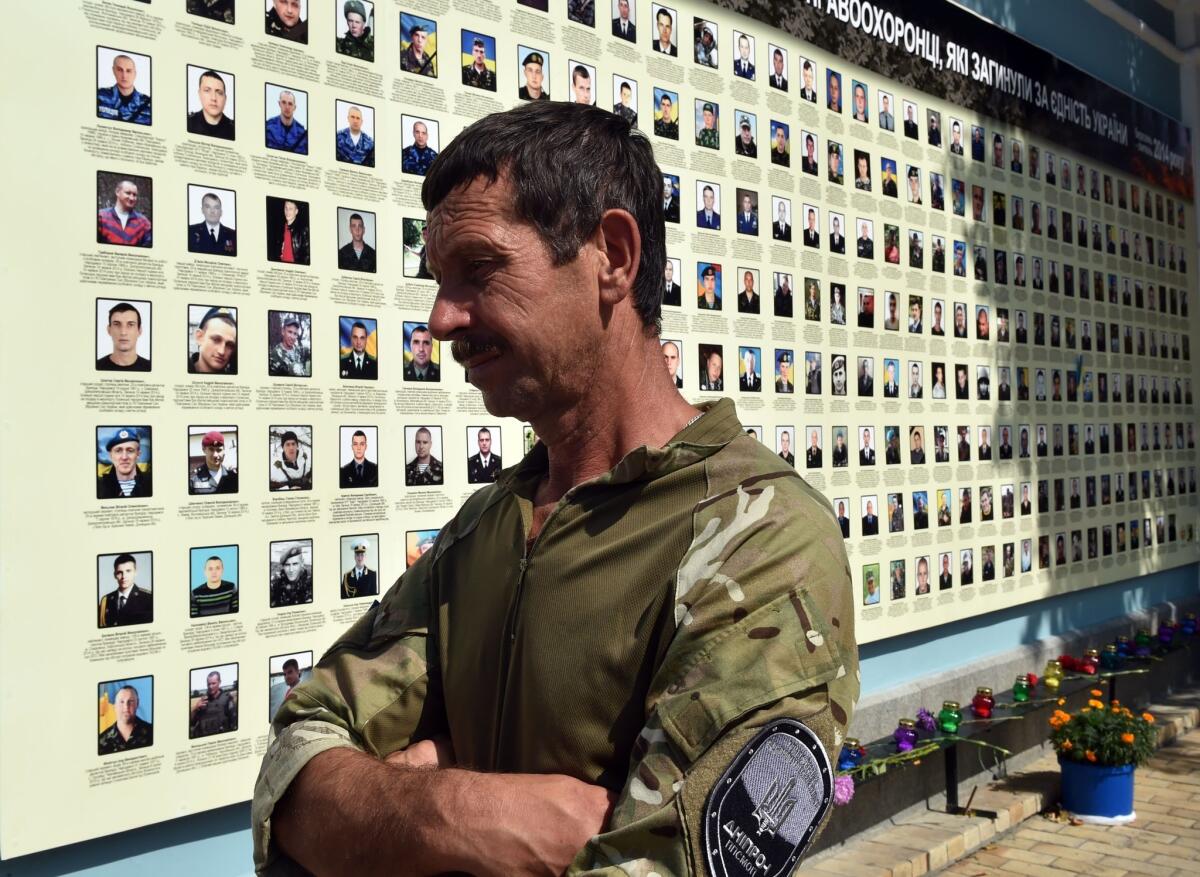U.N. reports nearly 8,000 deaths in Ukraine war, laments Russian role

A Ukrainian serviceman reviews a memorial erected in Kiev in late August honoring dead government fighters from the August 2014 battle for Ilovaisk near Donetsk.
- Share via
Almost 8,000 people are confirmed dead in the 17 months of fighting in eastern Ukraine, the United Nations’ human rights agency said Tuesday in a report that admonished Russia’s involvement in the deadly crisis.
The report by the U.N. Human Rights Monitoring Mission in Ukraine noted that large-scale offensives have been few in recent months but that the number of civilian deaths and injuries had more than doubled since May in comparison with the previous three-month period.
The rising toll among innocents results from the pro-Russia separatists and Ukrainian government forces waging artillery attacks on populated areas, the report noted.
“More needs to be done to protect civilians and put a complete stop to the hostilities, in accordance with the February cease-fire agreement,” U.N. High Commissioner for Human Rights Zeid Raad Hussein told a news conference in Geneva.
The Feb. 12 peace plan brokered by France and Germany called for a cease-fire to begin three days later and for all heavy weaponry such as tanks, rocket launchers and howitzers to be pulled from the front lines and stored in monitored depots.
But the cease-fire has been violated by both sides on a near-daily basis, the latest report of the monitoring mission said, and neither the rebels nor the government forces fully complied with the provision that their heavy weapons be surrendered.
The combatants in late August announced a renewed commitment to the cease-fire to coincide with the Sept. 1 start of the school year. It has mostly been observed, Hussein said, but monitors remain deeply concerned as both sides gear up for the approaching winter.
“The situation in Ukraine continued to be marred by ongoing armed hostilities in some areas of Donetsk and Luhansk regions reportedly fueled by the presence and continuing influx of foreign fighters and sophisticated weapons and ammunition from the Russian Federation,” the report said in the monitors’ most direct criticism of the Kremlin’s hand in the Ukraine conflict since fighting began in April 2014.
The monitors also reported “concern that the Russian Federation has continued to send white-truck convoys without the full consent or inspection of Ukraine, and their exact destination and content could not be verified.”
Under the label of humanitarian aid, the Russian Ministry for Emergency Situations has sent at least 40 convoys of 60 or more cargo trucks each into rebel-held areas and offloaded their contents out of sight of the dozens of monitors deployed in the region by the Organization for Security and Cooperation in Europe.
OSCE is the only international security alliance that includes both Ukraine and Russia as members and has been the only foreign observer force permitted in the separatist-controlled areas of eastern Ukraine. The monitors’ work is often thwarted by the gunmen, though, the alliance notes in its daily reports on cease-fire violations and suspicious deliveries of supplies and armed fighters.
The monitoring mission also criticized the separatists’ “development of more centralized civilian administrative structures and procedures” in the Donetsk and Luhansk regions they control. That statement alluded to the imposition of independent government offices and law enforcement bodies to replace those of the Ukrainian government, which has no access to the rebel-held regions.
“They do not conform with either international law or the national legislation of Ukraine,” the rights group said, noting that more than 3 million people live in the separatist-held territory and are cut off from the support and services of the Ukrainian government in Kiev.
Ukrainian leaders and their Western allies accuse Russian President Vladimir Putin of instigating the eastern Ukraine rebellion by invading Ukraine’s Crimea region and annexing it to Russia in March 2014. The Kremlin justified its territorial seizure as a move to protect the predominantly Russian population of the Black Sea peninsula from what it described as a fascist takeover in Kiev after Kremlin-allied President Viktor Yanukovich was driven into exile by a pro-European rebellion.
Days after the Crimean annexation, armed men arrived from Russian territory to the Donetsk, Luhansk and Kharkiv regions and occupied local government buildings and military sites. The pro-Russia gunmen were driven out of Kharkiv, which remains loyal to the government, but they have bolstered operations in the other two areas and steadily dismantled most vestiges of Kiev’s authority.
The U.N. report said at least 7,962 deaths have been confirmed in eastern Ukraine since April 2014, among government forces, pro-Russia rebels and civilians. At least 17,811 others have been injured, it said.
Follow @cjwilliamslat for the latest international news 24/7
More to Read
Sign up for Essential California
The most important California stories and recommendations in your inbox every morning.
You may occasionally receive promotional content from the Los Angeles Times.











